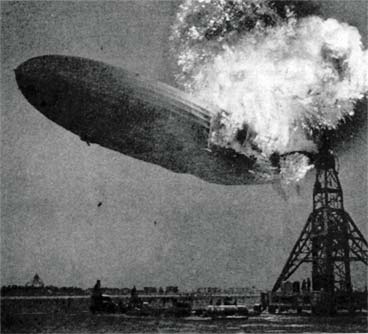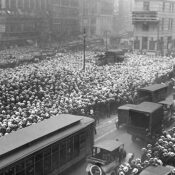It could have begun as a tiny spark — we may never know precisely. Whatever the cause, it ignited the 7,000,000 cubic feet of explosive Hydrogen inside the German airship. Hindenburg.
This photograph, by Gus Pasquarella, freezes the catastrophe that took place 295 feet above Lakehurst Air Station, amid the piney flatlands near the Jersey shore.
The time is 7:25 PM, daylight savings time, May 6, 1937. By 7:26, the Hindenburg was lying on the ground, a sagging framework of glowing steel. This single minute was crowded with tragedy, luck, and instinctive heroism.
The explosion was muffled under the mass of the dirigible so that several seconds passed before passenger realized what had happened. Several leapt to their deaths. Others waited while the dirigible slowly lost altitude, then jumped. Many of these survived the fall and began running to safety before the dirigible frame could land on top of them. Others were crushed. And others, too close to the descending inferno, were vaporized by the intense heat. Yet 62 of the 97 people aboard managed to survive the fall and the fire.
The photograph has become an icon of tragedy. Instantly recognizable, it speaks to us of the imminence and awful majesty of unimaginable disaster. It shocked Americans when it was released the following day. The horror it evoked effectively ended commercial travel by dirigible in the US and other nations. (It helped that international airplane service had begun. It was noisy and crowded, but faster and, Americans assumed, safer.)
Images of the flaming airship also had political implications. Hitler had been proud of this massive symbol of German might. The Hindenburg was a valuable tool for propaganda. In its previous ten trips to the United States, it had enabled the German Reich to fly the swastika in stately elegance in the skies over New York, and to defy the American government. Roosevelt had banned the sale of Helium to Germany out of fear it would be used for military purposes. But the German engineers had constructed an airship that used Hydrogen.
But hydrogen is extremely flammable. In a Post article, historian John Toland described how careful the German crew had been:
“The Germans were proud of their precautions. All matches and lighters had been confiscated when passengers boarded at Frankfort. As a further safety measure, the three catwalks, including the main one, which ran along the very bottom of the ship from bow to stern, were covered with rubber. Those treading the narrow ‘sidewalks’ wore sneakers or felt boots to prevent static or sparks. Crewmen who went topside between the billowing gas cells wore asbestos suits free of buttons or metal.
“And the four 1100-horsepower Diesel engines that drove the ship at a dead air speed of 84 miles an hour required no ignition. They used a crude oil with a flash point so low that it wouldn’t burn even if a flaming match was tossed into the tank.”
But all the precautions and all the efficiency couldn’t protect the Hindenburg, or its passengers.
While the crash ended any hope for dirigible travel, the photograph produced an even greater effect; it introduced America to modern journalism. They recognized that this photograph conveyed the tragedy better than the best journalists’ efforts. It was dreadful but it was fascinating, and it raised Americans’ expectations for greater detail and objectivity.
In addition to this photograph there was the recording of radio announcer Herbert Morrison, who was covering the event for radio station WLS in Chicago. His frantic, anguished reporting is often played in synch with motion picture footage shot at the time. However, he was recording the event onto a phonograph record, which the station intended to play the next day for an evening news program.
Toland describes Morrison’s preparations for the Hindenburg’s arrival.
“Inside a little building attached to the west side of the dirigible hanger, Herbert Morrison, an announcer from Station WLS, Chicago, checked over last minute adjustments with his engineer, Charlie Nehlsen. They were to make a recording of the year’s first transatlantic-flight landing… and Nehlsen had just finished setting up his portable recorder.
“As the Hindenburg floated [into sight], Morrison, a small, lantern-jawed man of about 120 pounds, called out, ‘Charlie, I’m going out for the recording.’ He left the building, which also housed the Navy’s radio station, walked onto the field and began talking into his hand microphone.
“Morrison had just announced that this was Captain Pruss’ first command – though actually it was the tenth time Pruss had captained the Hindenburg on a transatlantic flight. ‘Passengers are looking out the windows, waving.’ Morrison went on. ‘The ship is standing still now.’
“There was now a strange quiet. The Hindenburg’s engines were turning over slowly, silently. ‘The vast motors,’ Morrison said, ‘are just holding it, just enough to keep it from —’
“He stopped short. It was exactly 7:25 p.m.
The noise of the explosion was muffled to those directly beneath it, but it was strong enough to knock the whitewash from the ceiling of the room where the engineer was recording Morrison’s report. Nehlsen wiped off the record without stopping it and signaled Morrison to keep talking.
“To Morrison, it looked as though everyone on the ship and most of the ground crew would be killed instantly. ‘It’s bursting into flames and falling on the mooring mast!’ he shouted desperately. Tiny figures seemed to be catapulted from the dirigible, and fell. ‘This is terrible!’ Morrison cried, ‘This is one of the worst catastrophes in the world!’ His agonized voice trailed off into incoherence. He turned desperately toward Nehlsen, who was watching from the window.
“The engineer gave the OK signal, ‘Keep going,’ he said in pantomime.
“’Oh, the humanity and all the passengers!’ Morrison broke into sobs. ‘I told you —- It’s a mass of smoking wreckage! Honest, I can hardly breathe!’ Again, he looked at Nehlsen; again Nehlsen nodded encouragement.”
“’I’m going to step inside where I can’t see it!’ Morrison said, ‘It’s terrible! I—I—folks, I’m going to have to stop for a moment because I’ve lost my voice! This is the worst thing I’ve ever witnessed!’“Never had a disaster hit with the impact of the Hindenburg explosion. Never before had photographers and newsreelmen been present to record a major tragedy, and within hours shocking pictures of the fire were wired all over the world. By noon the next day, newsreel extras of the catastrophe were being shown in theaters along Broadway. It was a rare showing which wasn’t punctuated by screams from the audience.
In a more ordered world, the public was protected from the direct impact of news. There were hours of intervening calm, as well as banks of editors who removed the shock and hysteria from a reporter’s copy. The story would appear the next morning, set in cold type and couched in serious, thoughtful tones.
But Morrison’s report gave America a taste of what modern media — with its immediate and detailed reporting— would bring. It introduced the sound of emotional turmoil, the hysterical frustration of impotently watching a disaster. It was a feeling most Americans experienced on September 11, 2001.
As newspapers, then motion pictures, then television brought viewers closer to the instant and location of catastrophes, we sometimes feel the need, as did Morrison, to “step inside where I cannot see it.”
Read “Terror in the Twilight”[PDF].
Become a Saturday Evening Post member and enjoy unlimited access. Subscribe now




Comments
Seems to me, this expresses the time that we live in: Even if you have to go through a keyhole, get me close enough to smell the dirty laundry–and show it, repeatedly.
We were in the main dining room.
Our parents called us to see
The landing that would turn to doom –
The Hindenburg in New Jersey.
There was a blast and then fire spread.
My brother and sister were thrown
From me, as flames struck at my head.
I did not want to die alone.
But somehow Mother grabbed me tight.
Father was no longer alive.
The rest of us plunged into night.
Sister Irene did not survive.
The Hindenburg brought tragedy
To us, the Doehner family.
I was a little girl in the Bronx when the Hindenburg flew over heading for Lakehurst. We all stood out watching it sail slowly overhead and then my father went in and turned on the radio to hear the account of its landing. I will never forget !